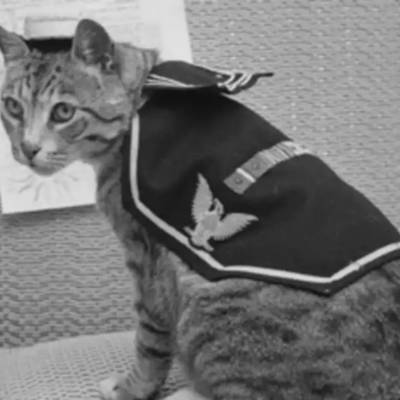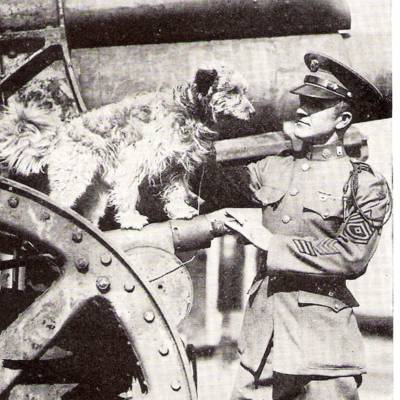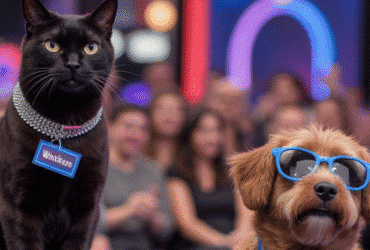
Veterinary Corporations
Hi everyone and thanks for joining me on this episode of Val Talk’s Pets. On this episode I want to explore something that has been happening in the veterinary world […]
 play_arrow
play_arrowDog and Cat Trivia Challenge 1.3 Val Cairney

 play_arrow
play_arrowCat and Dog War Heroes Val Cairney

Hi everyone, and thanks for joining me on this episode of Val Talk’s Pets. Well, it is that time of year again when we remember and pay respects to all the military personnel past and present that have fought in wars and conflicts the world over, serving their countries with dedication and sacrifice. Now I have done a Remembrance Day episode on animals in war. From dogs to elephants, pigeons, horses, donkeys, mules, cats, and even camels, animals have made a huge contribution to military efforts. So, for this episode, I’d like to focus on some particular cat and dog heroes who have gone down in history for their contributions.
Cats, believe it or not, have had quite the roll during war. Horses, mules, and dogs were placed in more official capacities, but cats had some very significant contributions as well. Navy ships were often very welcoming of cats to help with any rodent issues, and they did the same in barracks and field offices. Of course, a resident kitty could also help boost morale with some, as we all know how petting or cuddling a cat can be very calming. Some became quite famous.

Let’s start with Crimean Tom. Crimean Tom was associated with the British Army during the Crimean War. According to Wikipedia, “during the Crimean War, British and French forces captured Sevastopol (Sev-a-stopol) from the Russians on the 9th of September 1855, after an almost year-long siege. Lieutenant William Gair of the 6th Dragoon Guards, who was seconded to the Field Train Department as a deputy assistant commissary, led patrols to search the cellars of buildings for supplies. Gair noticed a cat, covered in dust and grime, that was sitting on top of a pile of rubbish between two injured people. The cat, unperturbed by the surrounding commotion, allowed himself to be picked up by Gair. The cat, estimated to have been 8 years old when found, had survived within the city throughout the siege. Gair took the cat back to his quarters, where he lived and ate with a group of British officers who initially named him Tom and then Crimean Tom. The occupying armies were struggling to find supplies, especially food, in a city much deprived by the year-long siege. It is said that the officers noticed how fat Tom was getting and realized he must have been feeding off a good supply of mice nearby. Knowing that the mice themselves had been feeding off hidden Russian supplies, they followed Tom to an area cut off by the rubble. Here, they found a storeroom with food supplies that helped save British and French soldiers from starvation. Tom later led the officers to several smaller caches of supplies near the city docks. After the war ended, Gair brought Tom back to England to keep as a pet, but the cat died on the 31st of December 1856.”

Our next war kitty has quite a folklore or folktale, shall we say, following his exploits enough so that just as I was researching this kitty, I also heard Aaron Mahnke talk about him on an episode of Lore! This is the story of Unsinkable Sam. Unsinkable Sam was what we would call a Tuxedo cat. Black and White has gone down in history as the cat that survived three World War II shipwrecks. According to allthatsinteresting.com, “for five years, Sam escorted U.S. Navy men bound for combat in the Atlantic during World War II.” To preface Sam’s story, we have to know that the “Nazis’ Navy launched the battleship Bismarck in 1939.” “By 1941, the Bismarck had reached the northern part of the Atlantic Ocean in an attempt to sabotage the naval envoys carrying supplies between Canada and the U.K.” Sam was actually aboard the Bismarck. The British Royal Navy on May 27, 1941, engaged the Bismarck and a three-day battle ensued. The Brits sank the Bismarck, and out of the 2200 personnel on board, only 114 survived, one of them being Sam the cat (allthatsinteresting.com). The tale goes that as the HMS Cossack was attempting to rescue survivors, they spotted a cat floating on a plank. The cat was brought aboard and originally named Oscar. “But several months later, the Cossack suffered a disaster of its own when it was sunk by a German torpedo. But, yet again, Oscar was rescued by the crew of the aircraft carrier HMS Ark Royal.
It was while aboard this ship that Oscar is said to have received his infamous nickname “Unsinkable Sam”. (allthatsinteresting.com) And again, “on November 14th, 1941, about a month after Sam was rescued, the Ark Royal was torpedoed. The ship was decimated, but Unsinkable Sam went unscathed. He was allegedly rescued for a third time by the HMS Legion.” Sam’s story is really a tale. But it is said that “according to Britain’s Royal Museums Greenwich, the cat retired to land, where he was placed in the offices of the Governor of Gibraltar. He was later adopted by a seaman who lived in Belfast, and that is where he died in 1955.”
There are a lot of holes in the story of Sam, so that makes it a bit of a folktale. And if we do the math, if Sam had been, say, 1 or 2 years old on the Bismarck and died in 1955, he would have at least been 16 years old. Now this is by no means out of the plausible, but that would have made him quite a senior cat in those days, and given his history, making it to at least 16 and possibly older is a feat. But just because some of the records fail to mention a Tuxedo cat on board doesn’t mean he didn’t exist. I prefer to believe. I believe that Unsinkable Sam was a hero who survived, giving lots of sailors support with his tenacious personality.

Our next kitty is Pooli. Pooli was actually short for Princess Papule. According to the cat’s meow rescue, Pooli was a large domestic shorthaired cat, born July 4th, 1944, “in the naval yard at Pearl Harbor. She was brought on board the USS Fremont, an attack transport that was ultimately involved in battle at the Marianas, the Palau group in the Philippines, and Iwo Jima.” It was said that when the battle stations alarm went off, she would race to the mailroom and curl up in a sack. Pooli did well, avoiding any drama until the ship was heading home to San Francisco. “Some of the sailors considered throwing her overboard for fear they would be quarantined because of her. But those who love the kitty placed a round-the-clock guard on her room for three days until the ship docked—without incident. Following the war, Pooli lived a long, happy life and earned three service ribbons and four battle stars. There was a mention for Pooli on her 15th birthday and a photo of her wearing her uniform, which of course she still fit into! She looks so cute in her uniform, complete with the navy bib at the back of her collar.

Simon was also a Tuxedo cat and had a book written about him called Able Seacat Simon, written by Lynne Barrett-Lee. According to Wikipedia, Simon lived from 1947 to 1949. Not very long, but he made an impact serving on the Royal Navy sloop-of-war HMS Amethyst. “In 1949, during the Yangtze Incident, he received the PDSA’s Dicken Medal, PDSA standing for People’s Dispensary for Sick Animals, after surviving injuries from an artillery shell, raising morale, and killing off a rat infestation during his service.” “Simon was found wandering the dockyards of Hong Kong in March 1948 by 17-year-old Ordinary Seaman George Hickinbottom, a member of the crew of the British frigate HMS Amethyst.” Simon was smuggled aboard but eventually became the frigate’s lucky mascot, catching rats and sleeping in the captain’s cap.
The Amethyst traveled up the Yangtze River to replace a duty ship in Nanjing. Halfway through, the Amethyst became embroiled with a Chinese PLA field gun battery when it opened fire on the frigate. Because Simon was often in the captain’s cabin, he was seriously injured when a “round tore through the captain’s cabin.” As Wikipedia says, “The badly wounded cat crawled on deck and was rushed to the medical bay, where the ship’s surviving medical staff cleaned his burns and removed four pieces of shrapnel.” The medical staff didn’t think Simon would survive, but he did and returned to his duties. The former captain of the Amethyst had died of his wounds after the attack, and unfortunately, the new captain, Lieutenant Commander John Kerans, was not really a fan of Simon. But Simon went back to work with vigor, removing rats that had overrun the ship.
After the Yangtze incident, Simon became quite the celebrity. He was presented with the “animal Victoria Cross” and the Dicken Medal. He was also awarded a Blue Cross and the “fanciful rank of Able Seacat.” When the Amethyst returned to the U.K, Simon, despite his celebrity and awards, “was subject to quarantine regulations and was immediately sent to an animal centre in Surrey”. “While in quarantine, Simon contracted a virus and, despite the attention of medical staff, died on the 28th of November 1949, from a complication of the viral infection caused by his war wounds. Hundreds, including the entire crew of the HMS Amethyst, attended his funeral at the PDSA Ilford Animal Cemetery in east London. His gravestone reads, In memory of “Simon ” served in H.M.S. Amethyst, May 1948 – November 1949. Awarded Dicken Medal August 1949. Died 28th November 1949. Throughout the Yangtze incident, his behaviour was of the highest order.” Simon made such an impact in his short life as a war hero, and to finish out cats in war is a list of those brave kitties that served. Aussie, RMS Niagara, Blackie, HMS Prince of Wales, Camouflage U.S. Coast Guard, Chibley, HMS Hermione, Emmy, RMS Empress of Ireland, Felix, Mayflower II, Halifax, the Roger Henry, Jenny, the Titanic, Kiddo, Airship America, Mrs. Clippy, the Endurance, Peebles, HMS Western Isles, Tiddles, Royal Navy Aircraft carrier HMS Argus, and Togo, HMS Dreadnought, to name a few.
Let’s have a look now at some of the dogs that have become heroes.

Rags was a terrier mix that served as the U.S. 1st Infantry Division’s dog mascot during WWI. Rags was originally adopted from France by Private James Donovan. Donovan, according to Wikipedia, “was seriously wounded and gassed, dying after returning to a military hospital at Fort Sheridan in Chicago. Rags was adopted by the family of Major Raymond W. Hardenbergh in 1920. Private Donovan’s job in the front line was to string communications wire between advancing infantry and supporting field artillery. He also had to repair field telephone wires that had been damaged by shellfire. Until wire was replaced, runners had to be used, but they were frequently wounded, killed, or could not get through shell holes and barbed wire.”
Private Donovan taught Rags to carry written messages that he attached to Rag’s collar. Wiki tells the story of how “in July 1918, Rags and Donovan and an infantry unit of 42 men were cut off and surrounded by Germans. Rags carried back a message, which resulted in an artillery barrage and reinforcements that rescued the group.” In September 1918, Rags and Donovan were involved in the final American campaign of the war. Rags carried a number of messages and, on October 2, 1918, carried one from the 1st Battalion of the 26th Infantry Regiment to the 7th Field Artillery, which resulted in an artillery barrage that led to an important objective, the Very-Epinonville (e-p-on-ville) Road, being secured. It saved the lives of a large number of soldiers.
On October 9th, 1918, Rags and Donovan were both victims of German shellfire and gas shells. Rags had his right front paw, right ear, and right eye damaged by shell splinters and was also mildly gassed. Donovan was more seriously wounded and badly gassed. The two were kept together and taken back to a dressing station and then several different hospitals.” Rags died at the age of 20 and was buried with military honors, and a monument was erected at Aspin Hill Memorial Park in Silver Spring, Maryland.
During World War II, families would often donate their dogs for duty. This happened to a German Shepherd mix named Chips. Chips was assigned to the War Dog Training Center in Virginia, where he was trained as a sentry dog. As Wikipedia says, Chips was one of four dogs “assigned to the 3rd Infantry Division in North Africa, Sicily, Italy, France, and Germany. His handler was Private John P. Rowell. “Chips and Rowell were pinned down on the beach by an Italian machine-gun team. Chips broke from Rowell and jumped into the pillbox (the structure where defenders could fire), attaching the gunners. The four crewmen were forced to leave the pillbox and surrender to the US troops. Rowell said, “There was an awful lot of noise. Then I saw one fellow come out the door with Chips at his throat. I called him off before he could kill the man. In the fight, he sustained a scalp wound and powder burns. Later that day, he helped take ten Italian prisoners.”
Chips was awarded the Distinguished Service Cross, Silver Star, and Purple Heart. But Army policy would not let Chips keep the medals, as the commendation was not allowed to be given to animals. His awards were revoked. However, “his unit unofficially awarded him a theater ribbon and battle stars for each of his eight campaigns.” “Chips was discharged in December 1945 and returned to his family.” “In 2018, Chips was posthumously awarded the PDSA Dickin Medal and in 2019 the Animals in War and Peace Medal of bravery.
Let’s talk a little bit about Smokey, a Yorkshire terrier in World War II. As Wikipedia explains, Smokey was found in an abandoned foxhole in the New Guinea jungle in February 1944. Smokey was sold around a few times but ended up with Corporal William A. Wynne. Smokey was adept at being in a backpack and accompanied Wynne on combat flights in the Pacific. Unfortunately, Smokey wasn’t designated as an official war dog, so she did not get veterinary care or food except for what Wynne shared with him. “Smokey served in the South Pacific with the 5th Air Force, 26th Photo Reconnaissance Squadron, and flew 12 air and sea rescue and photo reconnaissance missions.”
“Smokey was credited with twelve combat missions and awarded eight battle stars. She survived 150 air raids on New Guinea and made it through a typhoon in Okinawa. Smokey even parachuted from 30 feet in the air, out of a tree, using a parachute made just for her. Wynne credited Smokey with saving his life by warning him of incoming shells on an LST (transport ship), calling her an angel from a foxhole.”There is a monument to Smokey in Lakewood, Ohio.” Well, little Smokey, despite not receiving the designation officially, was definitely a dog of war.

Let’s talk a little bit about Lex. Lex was a German shepherd stationed in the military police department at Marine Corps Logistics Base Albany. Lex and his handler Corporal Dustin J. Lee were deployed in 2006 as an explosive detection and patrol team for 3rd Reconnaissance Battalion, then part of Regimental Combat Team 6 in Iraq. “While at a Forward Operating Base, they were hit by a 73 mm, SPG-9 rocket attack. Lee was mortally wounded, while Lex sustained shrapnel wounds. Despite his own wounds, Lex refused to leave Lee and had to be dragged away for corpsmen and other medics to attempt treatment.” Lex did recover and was returned to duty. However, Corporal Lee’s family petitioned to adopt Lex and after much petition and media campaign, the Lee family was eventually allowed to adopt Lex. Lex died on March 25, 2012 and was the recipient of an honorary Purple Heart.
Very similar to Lex, Nemo, also a German shepherd, served in the VietNam war as a sentry dog. During an attack on their airbase, Nemo alerted his handler Airman Robert Throneburg to hidden Viet Cong. Nemo and Throneburg killed two V.C’s. Like Lex, only in this case the handler survived, Throneburg was wounded during the attack and Nemo, “crawling across Throneburg’s body, guarded his handler against any who dared to come near him until medical help could arrive.”
Okay, so I saved the last spot for Sergeant Stubby. Stubby has been called the most decorated war dog of World War I. From four books to an animated film, Stubby is one of the most memorable war dogs. Stubby was the only dog to be nominated and promoted to sergeant through combat. Stubby was often described as an American bull terrier or Boston terrier mix.
“Stubby was found wandering the grounds of the Yale University campus in New Haven, Connecticut, in July 1917 while members of the 102nd Infantry were training.” One of the soldiers, Corporal James Robert Conroy, took a shine to the wandering dog. When Conroy had to ship out, he smuggled Stubby on board the troop ship. Conroy hid Stubby when they were getting off the ship in France, but eventually the commanding officer discovered Stubby. Conroy had been teaching Stubby to salute, which he did to the commanding officer, and he was then allowed to stay.
As Stubby’s history explains, “he served with the 102nd Infantry Regiment in the trenches in France for 18 months and participated in four offensives and 17 battles. He entered combat on February 5th, 1918, at Chemin des Dames (Che man de dam) north of Soissons (swaa-saan), and was under constant fire, day and night, for over a month. In April 1918, during a raid to take Seicheprey (sesh-pray), Stubby was wounded in the foreleg by retreating Germans throwing hand grenades. He was sent to the rear for convalescence, and as he had done on the front, he improved morale. When he recovered from his wounds, Stubby returned to the trenches.”
“In his first year of battle, Stubby was injured by mustard gas. After he recovered, he returned with a specially designed gas mask to protect him. He thus learned to warn his unit of mustard gas attacks, locate wounded soldiers in no man’s land, and since he could hear the whine of incoming artillery shells before humans, he became very adept at alerting his unit when to duck for cover. He was solely responsible for capturing a German spy in the Argonne (Ar-gone), leading to their unit’s commander nominating Stubby for the rank of sergeant.” The women of the town of Chateau-Thierry (tee-air-ee) made Stubby a chamois coat upon which his many medals were pinned. At the end of the war, Stubby and Robert Conroy returned home.
Stubby was a famous hero leading parades and meeting presidents. Stubby died in his sleep in March 1926. He was actually preserved by taxidermy and Conroy presented Stubby to the Smithsonian in 1956.
Well that is my journey through some of the most famous dogs and cats of war. As mentioned earlier, animals in war from horses, pigeons, elephants, camels; their contribution and sacrifice has been enormous. As we watch the leaves fall from the trees and feel the chill of winter coming, we also pay our respects through remembrance of all that have fought in the past and the present. I have a pin that I got from my local SPCA that specifically commemorates animals in war and conflict. I wear this with my poppy. Perhaps you can find something similar in your area. Wear it proudly if you can, to show that you know the sacrifice that war and peace keeping creates, by humans and by animals, because as I say, knowing is caring.

Tagged as: animal heroes, cat and dog war heroes.
Hi everyone, and welcome to Val Talk’s Pets, the forum for pet parents and enthusiasts alike. So, I have been working in the pet industry now for almost 10 years and, on a daily basis, I handle a lot of issues and questions arising from pet parents. I am not a veterinarian but I do have certifications in Canine, Feline, Small Animal, Fish and Herptile and Avian Health and Nutrition from the University of California, Davis Extension, the Vet College.

Val Cairney August 11, 2023
Hi everyone and thanks for joining me on this episode of Val Talk’s Pets. On this episode I want to explore something that has been happening in the veterinary world […]

Val Cairney October 3, 2025

Val Cairney September 19, 2025
For the price of a coffee, or more if you are feeling generous, you can help keep this podcast going & growing. Please visit my ko-fi page to make a donation. Thanks!
all rights reserved - Val Talks Pets - 2024